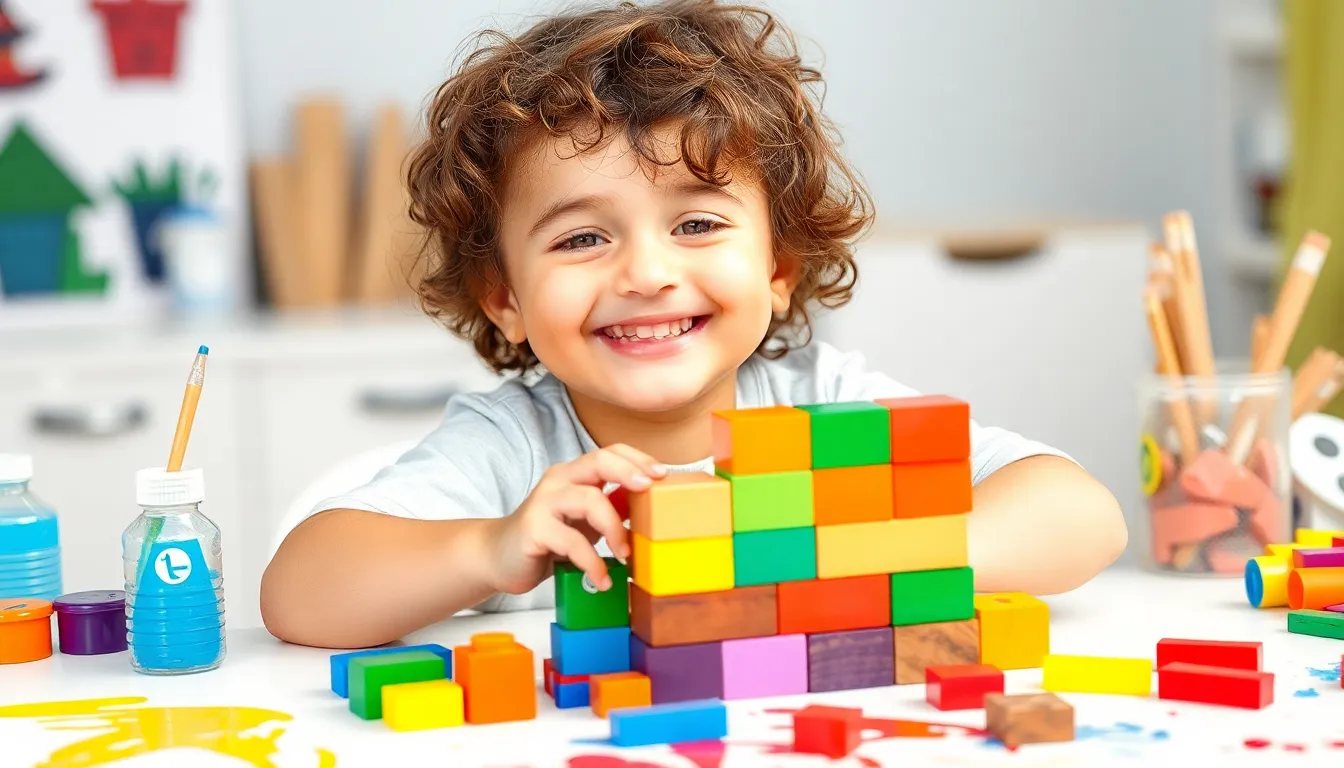Table of Contents
ToggleIn a world where kids are glued to screens, it’s time to unleash their inner scientists, artists, and engineers with some exciting STEAM activities! Parents and educators alike know that engaging preschoolers in hands-on learning not only sparks their curiosity but also lays the foundation for future success. Who knew that mixing baking soda and vinegar could lead to a mini volcanic eruption and a whole lot of giggles?
What Are STEAM Activities?
STEAM activities encompass a wide range of engaging and educational experiences that integrate Science, Technology, Engineering, Arts, and Mathematics. These activities encourage preschoolers to explore their surroundings and think critically. Through hands-on learning, children gain essential skills while having fun.
Science experiments spark curiosity and allow young learners to observe natural phenomena. Simple activities, like mixing water and food coloring, demonstrate principles of color mixing and absorption. Technology elements include using age-appropriate apps and tools to enhance learning experiences. Children interact with digital platforms that reinforce concepts they learn through play.
Engineering challenges promote problem-solving and creativity. Building structures with blocks teaches young minds about balance and stability. Arts components encourage self-expression through creative projects, combining craft supplies with thematic learning. Children express their ideas and emotions, enriching their overall educational journey.
Math concepts come to life with counting games and hands-on activities. Using measuring cups during cooking or baking projects introduces math in a practical context. Activities blend various STEAM disciplines, supporting holistic development. These experiences foster curiosity and creativity, essential for future learning opportunities.
Fostering an environment that promotes STEAM activities benefits preschoolers. Home and classroom settings provide numerous opportunities for exploration. Parents and educators can create engaging experiences that stimulate interest in STEAM subjects. Reinforcing concepts through practical activities helps solidify understanding.
Benefits of STEAM Activities for Preschoolers

Engaging in STEAM activities offers numerous advantages for preschoolers. These benefits support development and encourage a love for learning.
Enhancing Critical Thinking
Critical thinking develops as preschoolers participate in hands-on STEAM activities. Asking questions during experiments nurtures curiosity and prompts deeper exploration. Through problem-solving tasks, children learn to analyze situations and consider different outcomes. Activities like building simple machines encourage them to plan, test, and modify their designs based on results. Such experiences teach kids to evaluate their methods critically, leading to stronger decision-making skills. Engaging with materials like blocks introduces concepts of balance and structure, further enhancing analytical abilities. These foundational skills prove beneficial not only in academics but also in daily life.
Fostering Creativity
Creativity flourishes during STEAM activities by allowing preschoolers to express themselves. They explore various materials and techniques, which encourages innovative thinking. Open-ended projects, such as art with recycled materials, inspire imaginative solutions and personal interpretations. When children work on constructing structures or designing crafts, they tap into their creative potential and learn to embrace new ideas. Additionally, integrating elements like music or visual arts into science introduces unique ways for kids to connect concepts. Through exploration, preschoolers gain confidence in their abilities, leading to a willingness to experiment and take risks. Such creative engagement lays the groundwork for future artistic and scientific pursuits.
Popular STEAM Activities for Preschoolers
Engaging preschoolers in STEAM activities sparks curiosity and creativity. A mix of fun and education prepares them for future success.
Science Experiments
Simple science experiments excite young learners. Baking soda and vinegar create a mini volcano, demonstrating a chemical reaction. Mixing water with food coloring showcases color mixing, allowing children to explore visual changes. Mirrors and flashlights help kids investigate light reflection. These activities promote observation and give children hands-on experience with scientific concepts.
Technology-Based Games
Technology-based games enhance learning in preschoolers. Age-appropriate apps introduce coding through fun puzzles and challenges. Interactive websites offer virtual science experiments, encouraging exploration. Tablet-based activities can teach math through engaging games. Incorporating technology fosters digital literacy and supports skill development.
Engineering Projects
Engineering projects encourage creativity and problem-solving. Building structures with blocks challenges preschoolers to consider stability and balance. Simple machines like pulleys and levers allow children to experiment with engineering concepts. Creating bridges with everyday materials fosters teamwork and critical thinking. Hands-on projects inspire imaginative solutions to design problems.
Art and Craft Ideas
Art and craft ideas provide self-expression opportunities for preschoolers. Using recycled materials promotes creativity while teaching resourcefulness. Finger painting and collage-making help children explore different textures and colors. Collaborative art projects encourage social interaction and teamwork. Music integration enhances the artistic experience and fosters creativity.
Mathematics Activities
Mathematics activities make learning numbers fun. Cooking provides practical math applications, as children measure ingredients. Sorting toys by shape and size strengthens problem-solving skills. Counting games, both physical and digital, keep preschoolers engaged. Daily math activities reinforce a foundational understanding of mathematical concepts.
Tips for Implementing STEAM Activities at Home
Creating a stimulating atmosphere encourages preschoolers to explore STEAM concepts. Comfort and accessibility play key roles in setting up a fun learning environment. Designate a specific area for activities with ample space for movement and creativity. Stock this space with diverse materials like blocks, art supplies, and science kits. Bright colors and accessible shelves can inspire curiosity and engagement. Rotating activities keeps the space fresh and exciting, allowing children to experience something new regularly.
Engaging with your child during these activities deepens their understanding and enjoyment. Ask open-ended questions that prompt critical thinking, such as “What do you think will happen if we mix these two colors?” Share observations and take joint discoveries to encourage dialogue and collaboration. Demonstrating enthusiasm during activities fosters motivation and imagination, making learning enjoyable. Try participating side by side, showing that shared exploration can be fun. Encourage your child to express their thoughts about the activities, shaping their learning through conversation and interaction.
Engaging preschoolers in STEAM activities not only sparks their curiosity but also lays the foundation for essential skills they’ll use throughout their lives. By incorporating hands-on experiments and creative projects into daily routines, parents and educators can create a rich learning environment that encourages exploration and innovation.
These activities foster critical thinking and problem-solving abilities while allowing children to express themselves artistically. With a variety of resources and ideas available, it’s easier than ever to inspire young minds. Embracing the joy of learning through STEAM will nurture a lifelong love for discovery and creativity in preschoolers.







